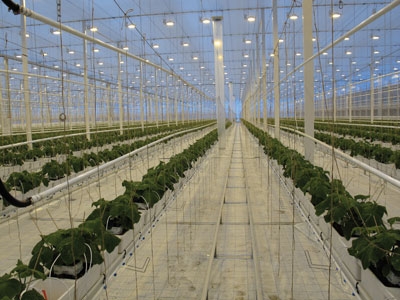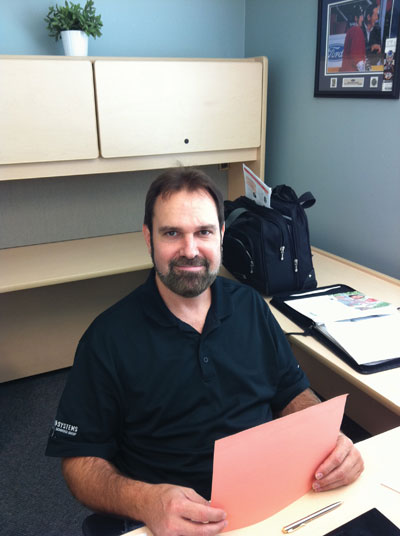
Features
Efficiency
Energy
Questions on lighting
June 25, 2012 By Treena Hein
 Growers add lighting to boost productivity and extend the season.
Growers add lighting to boost productivity and extend the season. In this recent ‘Greenhouse Canada Magazine’ article, a lighting expert answers some of the most commonly-asked questions he deals with on a fairly regular basis. James Grouzos is the U.S. sales engineer for P.L. Light Systems.
Q: I am growing in a greenhouse. How do I choose between HPS and metal halide?
A: When we look at the two different lamps, we see that metal halide offers more blue than HPS. Some people feel they need more blue to keep a crop from stretching or bolting. For the most part, we get ample amounts of natural blue light in a greenhouse, so the extra blue is not normally needed. Some people still use MH for propagation, indoor growing and some leafy crops.
Q: So why use the HPS lamp?
A: The HPS lamps give us more lumens per watt than MH and hold their output longer. Metal halides tend to depreciate in output more quickly. By using the HPS lamps, you’re getting more light for a longer period of time. More light equals more growth.
Q: So, I can leave the HPS bulb in for a longer time?
A: Well, yes and no. It is recommended to change your MH lamps at around 8,000 hours and at 10,000-12,000 for the HPS lamps.
You have to remember that while the bulb is still bright, after a number of hours your lamp is putting out less light. It actually pays to replace the lamps at a 10-15 per cent loss so that you keep the light levels up for optimum growth. If someone put a screen over your lamp to reduce your output by 15 per cent, you would say they were wasting your money and slowing down your crops. Well, the same happens when you leave a lamp in past its prime.
Change the bulbs when needed and you will have better growth and efficiency. It also puts less stress on the internal components and reduces maintenance costs.
Q: What else can I do to be efficient and keep my plants happy?
A: Sign up for a good light-care program. This will allow you to see how well your system is performing and to make educated decisions as to when to change bulbs, capacitors and reflectors.
Q: Why change reflectors? Mine look fine.
A: While the reflector may look fine, they get dirt accumulating on the surface, reducing the reflective qualities. You may not even notice a difference, but your plants can. It is recommended that you get reflectors checked with your light-care program so you can get feedback on them every few years. They may need no more than a simple cleaning to bring them up to par.
With the advancement of new metals and newer technologies, there are new reflectors on the market that can actually increase the output over the older reflectors. The new reflectors are thinner than the older ones because they are meant to be replaced after five or more years of service, depending on how dusty your greenhouse is.
If you would like five per cent or more light for your plants using the same electricity as before, test a few new delta or beta reflectors. Your crop will love you for it.
Q: Are there any new advancements in lighting fixtures besides reflectors?
A: Yes, you may have seen electronic fixtures, LEDs, daylight fixtures and other newer designs.
You may have seen an increase in electronic greenhouse fixtures over the past few years. These use circuit boards instead of the heavy magnetic ballasts and control the output to the bulb better.
They also are lighter, so less structure is needed on most projects. These are great for the newer light lifts that are now being used in some greenhouses.
LEDs are now being looked at for energy savings, but so far they have proven to be best in growth chambers and multi-layer culture where the fixtures are within 20” of the crops.
Now is a good time to start small and learn to grow under LEDs. Once the technology gets better and prices come down, you will then have the knowledge to use them effectively.
It’s important to remember LEDs also lose output over time. You then replace the whole unit in most cases, instead of a bulb as in HID fixtures.
You may see systems called Daylight fixtures this summer. These would be good for researchers looking for a full-spectrum lamp in an HID fixture. They’re not for everyone, but they do serve a target market.
Q: Where is the best place to learn about all the new designs on the market?
A: Contact a company that specializes in greenhouse lighting. They can be great sources of information. There is also a lot of good information on the Internet … but I find there is a lot of misinformation there, too.
IN SUMMARY
■ A good greenhouse lighting company should be able to do light calculations for your project, will know about micromoles and PAR (photosynthetic active radiation), and can show you some of their projects.

James Grouzos is the U.S. sales engineer for P.L. Light Systems. • www.pllight.com
Print this page